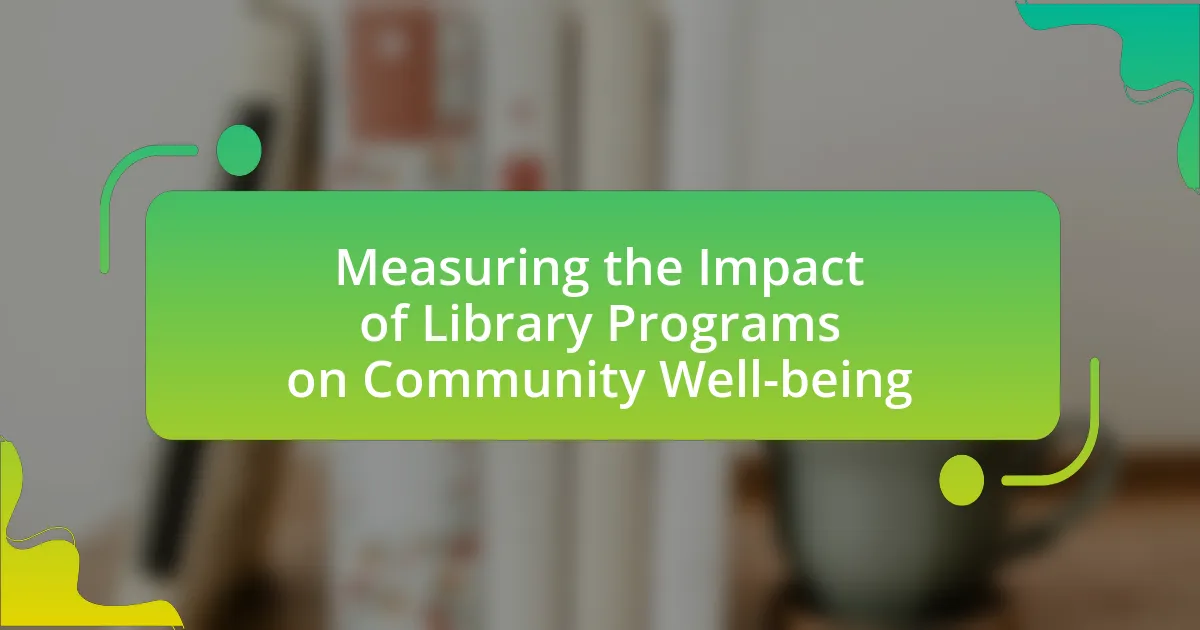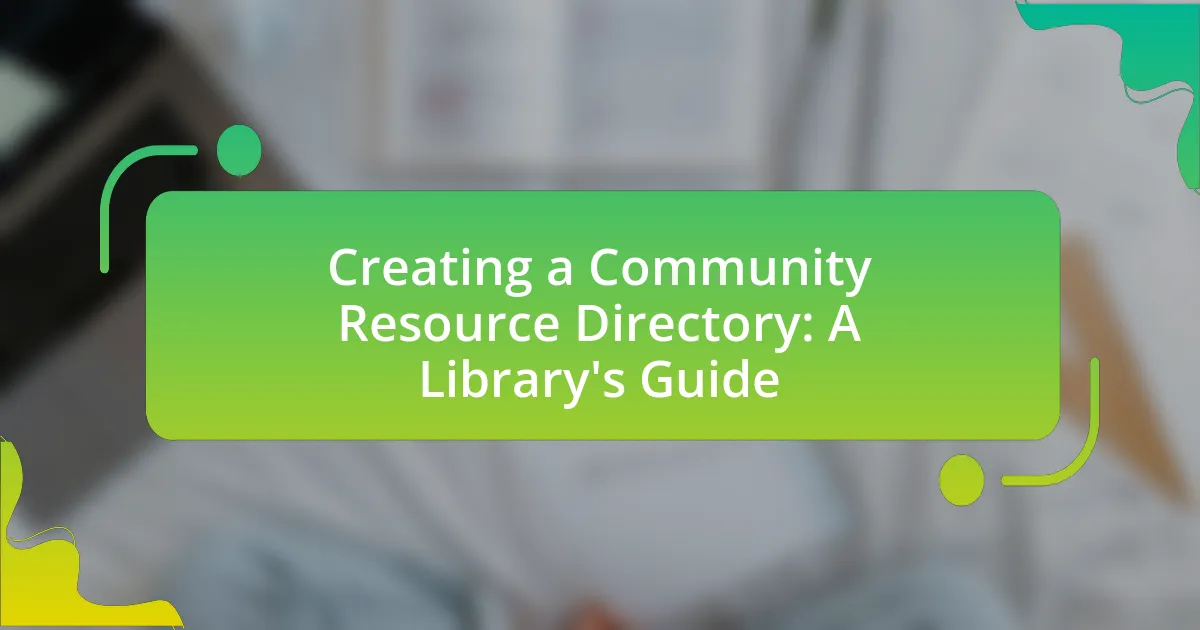Community surveys are essential tools for library program development, enabling libraries to gather valuable feedback from their communities regarding needs, preferences, and perceptions of services. These surveys help identify service gaps, assess user satisfaction, and prioritize program offerings, leading to increased engagement and participation. The article explores the methodologies for conducting effective community surveys, the types of information that can be gathered, and the impact of community demographics on survey outcomes. Additionally, it discusses best practices for survey design, strategies to enhance response rates, and the importance of ethical considerations in the survey process, ultimately highlighting how libraries can utilize survey results to improve their programs and better serve their communities.

What are Community Surveys in Library Program Development?
Community surveys in library program development are systematic tools used to gather feedback and insights from the community regarding their needs, preferences, and perceptions of library services. These surveys enable libraries to identify gaps in service, assess user satisfaction, and prioritize program offerings based on community input. Research indicates that libraries that actively engage with their communities through surveys can enhance user experience and increase program participation, as evidenced by a study conducted by the American Library Association, which found that libraries utilizing community feedback saw a 30% increase in program attendance.
How do community surveys contribute to understanding user needs?
Community surveys significantly enhance the understanding of user needs by directly gathering feedback from the target audience. These surveys provide quantitative and qualitative data that reflect the preferences, interests, and challenges faced by community members. For instance, a study conducted by the American Library Association found that libraries that implemented community surveys were able to tailor their programs and services to better align with user expectations, resulting in increased participation and satisfaction. This direct engagement allows libraries to identify gaps in services and prioritize resources effectively, ensuring that user needs are met in a timely and relevant manner.
What types of information can be gathered through community surveys?
Community surveys can gather various types of information, including demographic data, community needs and preferences, service usage patterns, and satisfaction levels with existing programs. Demographic data helps identify the characteristics of the community, such as age, gender, and education level, which can inform targeted programming. Understanding community needs and preferences reveals what services or resources residents desire, guiding library development. Service usage patterns indicate how often and in what ways community members utilize library resources, while satisfaction levels provide feedback on current offerings, highlighting areas for improvement. These insights are essential for effective library program development and ensuring that services align with community expectations.
How do community demographics influence survey outcomes?
Community demographics significantly influence survey outcomes by shaping the perspectives, needs, and preferences of respondents. For instance, age, income, education level, and cultural background can affect how individuals interpret survey questions and the types of services they prioritize. Research indicates that diverse demographic representation leads to more comprehensive insights; for example, a study by the Pew Research Center found that surveys reflecting varied age groups yield different priorities in library services, such as technology access for younger users versus community programs for older adults. Thus, understanding community demographics is essential for accurately interpreting survey results and tailoring library programs to meet the specific needs of the community.
Why are community surveys essential for library program development?
Community surveys are essential for library program development because they provide direct insights into the needs and preferences of the community. By collecting data from patrons, libraries can tailor their programs and services to better align with user interests, ensuring relevance and engagement. For instance, a study by the American Library Association found that libraries that actively seek community input through surveys see a 30% increase in program attendance, demonstrating the effectiveness of this approach in meeting community expectations.
What specific benefits do community surveys provide to libraries?
Community surveys provide libraries with essential insights into user needs and preferences, enabling them to tailor services effectively. By collecting data directly from community members, libraries can identify gaps in resources, understand patron demographics, and assess satisfaction levels. For instance, a study by the American Library Association found that libraries that conducted community surveys saw a 30% increase in program attendance, demonstrating the direct impact of aligning services with community interests. This data-driven approach not only enhances user engagement but also supports strategic planning and resource allocation, ensuring libraries remain relevant and responsive to their communities.
How can community surveys enhance user engagement and satisfaction?
Community surveys enhance user engagement and satisfaction by providing libraries with direct feedback from their patrons, allowing for tailored programs that meet specific needs. When libraries conduct surveys, they gather valuable insights into user preferences, interests, and areas for improvement, which can lead to more relevant and appealing services. For instance, a study by the American Library Association found that libraries that actively seek user input through surveys see a 30% increase in program attendance and user satisfaction ratings. This data-driven approach fosters a sense of community ownership and involvement, as patrons feel their voices are heard and valued, ultimately leading to stronger relationships between libraries and their users.

What methodologies are used in conducting community surveys?
Community surveys utilize various methodologies, including quantitative methods like structured questionnaires and qualitative methods such as focus groups and interviews. Quantitative surveys often employ random sampling techniques to ensure representative data, allowing for statistical analysis of community needs and preferences. For instance, a study by the American Library Association found that libraries using structured surveys could effectively identify user demographics and service gaps. Qualitative methods, on the other hand, provide deeper insights through open-ended questions, enabling participants to express their thoughts and experiences in detail. This combination of methodologies enhances the overall understanding of community needs, guiding library program development effectively.
How can libraries effectively design their community surveys?
Libraries can effectively design their community surveys by employing clear objectives, targeted questions, and diverse distribution methods. Establishing clear objectives ensures that the survey addresses specific community needs, which can be informed by previous data or community feedback. Targeted questions should be concise and relevant, utilizing both quantitative and qualitative formats to gather comprehensive insights. For instance, using Likert scales for satisfaction ratings alongside open-ended questions allows for nuanced responses. Additionally, employing diverse distribution methods, such as online platforms, paper surveys, and community events, increases participation rates and reaches a broader audience. Research indicates that libraries that utilize these strategies see higher engagement and more actionable data, ultimately enhancing program development and community service.
What are the key components of a well-structured survey?
A well-structured survey includes clear objectives, a defined target audience, concise and relevant questions, a logical flow, and a method for data analysis. Clear objectives ensure that the survey addresses specific issues or gathers particular information, which is essential for effective library program development. Defining the target audience allows for tailored questions that resonate with respondents, increasing engagement and response rates. Concise and relevant questions minimize confusion and bias, while a logical flow enhances the respondent’s experience, leading to more accurate data collection. Finally, a method for data analysis is crucial for interpreting results and making informed decisions based on the survey findings. These components collectively contribute to the effectiveness of surveys in gathering valuable insights for library program development.
How can libraries ensure a high response rate for their surveys?
Libraries can ensure a high response rate for their surveys by employing targeted outreach strategies and simplifying the survey process. Targeted outreach involves identifying specific community groups and utilizing multiple communication channels, such as email, social media, and in-person events, to engage potential respondents. Simplifying the survey process includes designing concise surveys with clear questions and providing incentives, such as gift cards or library credits, to encourage participation. Research indicates that surveys with fewer than 10 questions can increase response rates by up to 50%, demonstrating the effectiveness of these strategies in enhancing engagement.
What tools and technologies can assist in survey implementation?
Survey implementation can be effectively assisted by tools and technologies such as online survey platforms, data analysis software, and mobile survey applications. Online survey platforms like SurveyMonkey and Google Forms enable easy creation and distribution of surveys, allowing for real-time data collection and analysis. Data analysis software, such as SPSS or R, provides advanced statistical capabilities to interpret survey results accurately. Additionally, mobile survey applications facilitate on-the-go data collection, increasing response rates and accessibility. These tools streamline the survey process, enhance data quality, and improve overall efficiency in gathering community feedback for library program development.
Which online platforms are best suited for conducting community surveys?
The best online platforms for conducting community surveys include SurveyMonkey, Google Forms, and Qualtrics. SurveyMonkey offers customizable templates and robust analytics, making it suitable for diverse community needs. Google Forms is user-friendly and integrates seamlessly with other Google services, allowing for easy data collection and sharing. Qualtrics provides advanced survey features and analytics, ideal for in-depth research. These platforms are widely recognized for their effectiveness in gathering community feedback, as evidenced by their extensive user bases and positive reviews in the field of survey research.
How can data analysis software improve survey result interpretation?
Data analysis software enhances survey result interpretation by enabling efficient data processing and visualization. This software can quickly analyze large datasets, identify trends, and generate visual representations such as graphs and charts, which facilitate easier understanding of complex information. For instance, tools like SPSS and Tableau allow users to perform statistical analyses and create interactive dashboards, making it simpler to draw actionable insights from survey data. Furthermore, according to a study published in the Journal of Data Science, the use of data analysis software can reduce the time spent on manual data interpretation by up to 50%, thereby increasing the accuracy and reliability of the findings.

What are the challenges associated with community surveys?
Community surveys face several challenges, including low response rates, biased sampling, and data interpretation difficulties. Low response rates can hinder the representativeness of the survey results, as seen in studies where participation often falls below 30%, limiting the ability to generalize findings. Biased sampling occurs when certain demographics are overrepresented or underrepresented, which can skew results; for instance, surveys may attract responses primarily from individuals with strong opinions, thus failing to capture the views of the broader community. Additionally, interpreting survey data can be complex due to varying levels of understanding among respondents, leading to misinterpretation of questions or answers. These challenges can significantly impact the effectiveness of community surveys in informing library program development.
What common obstacles do libraries face when conducting surveys?
Libraries commonly face obstacles such as low response rates, limited resources, and challenges in reaching diverse populations when conducting surveys. Low response rates can hinder the collection of representative data, as seen in studies where only 10-20% of patrons participate in surveys. Limited resources, including staff time and budget constraints, restrict libraries’ ability to design, distribute, and analyze surveys effectively. Additionally, reaching diverse populations can be difficult due to language barriers, technological access issues, and varying levels of engagement with library services, which can skew results and limit the effectiveness of the surveys in informing program development.
How can libraries address issues of survey bias?
Libraries can address issues of survey bias by employing diverse sampling methods and ensuring inclusive question design. By utilizing stratified sampling techniques, libraries can reach underrepresented groups, thereby minimizing selection bias. Additionally, crafting questions that are clear, neutral, and culturally sensitive helps to avoid response bias. Research indicates that surveys designed with input from community members yield more accurate and representative data, as seen in studies conducted by the American Library Association, which emphasize the importance of community engagement in survey development.
What strategies can be employed to overcome low participation rates?
To overcome low participation rates in community surveys for library program development, targeted outreach strategies should be employed. These strategies include utilizing social media platforms to engage potential participants, offering incentives such as gift cards or library discounts to encourage responses, and collaborating with local organizations to promote the survey within their networks. Research indicates that surveys promoted through community partnerships can increase response rates by up to 30%, demonstrating the effectiveness of these outreach methods. Additionally, simplifying the survey design and ensuring it is accessible to diverse populations can further enhance participation.
How can libraries utilize survey results for program development?
Libraries can utilize survey results for program development by analyzing community feedback to identify needs and preferences. This data-driven approach allows libraries to tailor programs that align with the interests of their patrons, ensuring higher engagement and satisfaction. For instance, a survey might reveal a demand for digital literacy workshops, prompting the library to develop targeted training sessions. Research shows that libraries that actively incorporate community input into their programming see increased participation rates, as evidenced by a study from the American Library Association, which found that 75% of libraries reported enhanced program relevance after implementing survey feedback.
What steps should libraries take to analyze and implement survey findings?
Libraries should follow a systematic approach to analyze and implement survey findings by first organizing the collected data into manageable categories. This involves coding responses, identifying trends, and summarizing key insights to understand community needs effectively. Next, libraries should engage stakeholders, including staff and community members, to discuss the findings and prioritize actionable items based on the survey results.
Subsequently, libraries must develop an implementation plan that outlines specific programs or services to address the identified needs, including timelines and resource allocation. Finally, libraries should establish metrics for evaluating the success of the implemented changes, ensuring continuous feedback loops to refine programs based on ongoing community input. This structured approach is supported by research indicating that libraries that actively engage with survey data can enhance program relevance and community satisfaction.
How can libraries measure the impact of changes made based on survey feedback?
Libraries can measure the impact of changes made based on survey feedback by utilizing quantitative metrics such as usage statistics, attendance records, and follow-up surveys. For instance, after implementing changes suggested by survey respondents, libraries can track the increase in program attendance or circulation rates to assess effectiveness. Additionally, conducting follow-up surveys can provide direct feedback on whether patrons perceive the changes as beneficial, allowing libraries to quantify satisfaction levels and identify areas for further improvement. This method aligns with best practices in library science, where data-driven decision-making is essential for demonstrating the value of community input in program development.
What best practices should libraries follow when conducting community surveys?
Libraries should follow several best practices when conducting community surveys to ensure effective data collection and analysis. First, they should clearly define the survey objectives to align questions with the specific information needed for program development. This focus helps in gathering relevant data that directly informs library services.
Next, libraries should employ a mix of quantitative and qualitative questions to capture a comprehensive view of community needs and preferences. For instance, using Likert scale questions alongside open-ended responses allows for both measurable data and personal insights.
Additionally, libraries should ensure the survey is accessible to all community members, utilizing various formats such as online surveys, paper forms, and in-person interviews to reach diverse populations. This inclusivity increases response rates and enhances the representativeness of the data collected.
Furthermore, libraries should pilot the survey with a small group before full deployment to identify any issues with question clarity or survey length. This step can improve the overall quality of the data collected.
Finally, libraries must analyze the data systematically and share the findings with the community to demonstrate transparency and encourage future participation. By following these best practices, libraries can effectively gather valuable insights that drive program development and better serve their communities.
How can libraries ensure ethical considerations are met in survey processes?
Libraries can ensure ethical considerations are met in survey processes by implementing informed consent, ensuring confidentiality, and adhering to ethical guidelines established by professional organizations. Informed consent requires that participants are fully aware of the survey’s purpose, their rights, and how their data will be used, which fosters transparency and trust. Ensuring confidentiality protects participants’ identities and personal information, aligning with ethical standards that prioritize privacy. Additionally, libraries can follow ethical guidelines from organizations such as the American Library Association, which emphasizes the importance of ethical research practices. These measures collectively uphold the integrity of the survey process and respect the rights of participants.
What tips can enhance the effectiveness of community surveys in libraries?
To enhance the effectiveness of community surveys in libraries, it is essential to ensure clarity in survey questions and to engage the community in the survey design process. Clear questions reduce ambiguity, leading to more accurate responses, while involving community members fosters a sense of ownership and increases participation rates. Research indicates that surveys designed with community input can yield a 20% higher response rate, as seen in a study by the American Library Association, which highlights the importance of community engagement in library initiatives. Additionally, utilizing multiple distribution channels, such as online platforms and in-person events, can further broaden reach and inclusivity, ensuring diverse community representation in the feedback collected.






